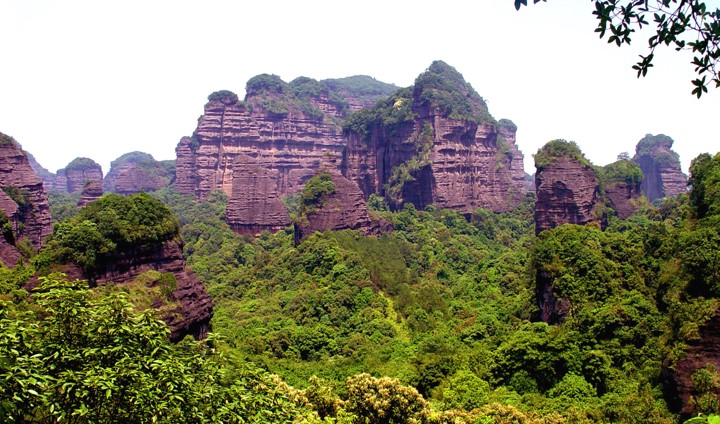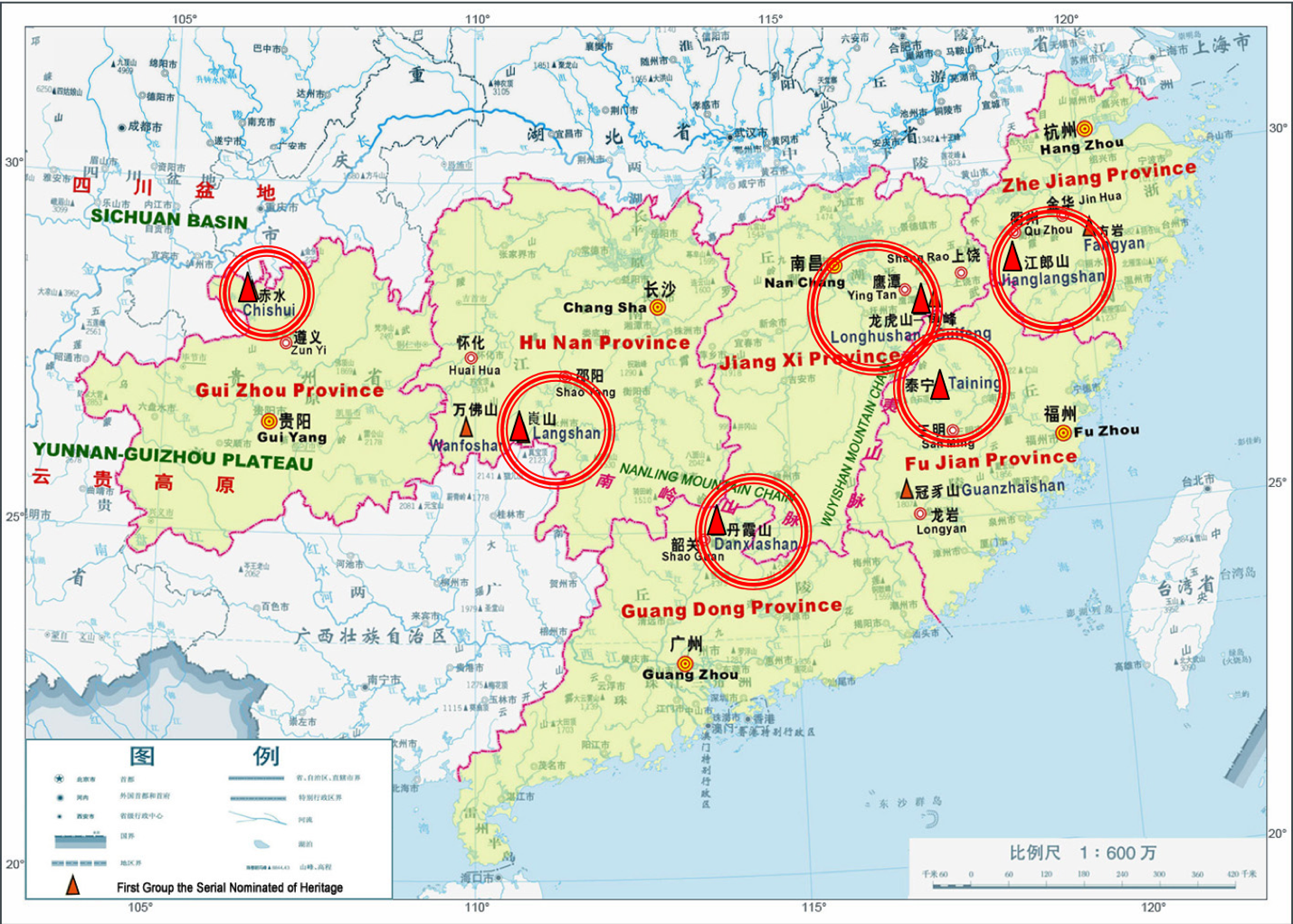The Politics of Valued Environments
Nature and Culture: An Interrelated Pair
Notably in the Western World, nature is often thought to be independent from human communities and, by extension, culture. However, as this page will show, nature – or the natural environment – is in fact a key part of the context of cultural processes. An ensemble of biotic and abiotic features, it both shapes and is shaped by mankind and their culture.
On one hand, nature presents as biophysical constraints to human activities. Cultures developed in different communities often bear the imprint of their respective adaptations to prevailing natural conditions. Consider, for example, the suspended wooden houses built by Miao people living in mountainous parts of Guizhou. In this way, physical diversity and cultural diversity can be highly correlated.
On the other hand, people modify nature as a key site of expression of their culture. Their modifications can be symbolic, related to assigning particular meanings to natural features, such as identifying a lake as sacred. They can also be more material and visible, as physical transformation of natural landscapes for various socioeconomic purposes, from resource extraction and opening up of new farmland. Given these considerations, natural features can be cultural traces as well, bearing symbolic and material impacts of culture.
Nature, Culture and Politics
Behind these modifications, or cultural traces, that people leave on nature is indeed a complex web of power relations. As the fundamental argument of an emerging research called political ecology (Robbins, 2012), nature is inherently political. This is because conflicts and struggles arise from time to time between individuals or communities over how we should engage with nature. This question of ‘how’ is meditated by one’s cultural background, which gives rise to particular views on nature’s values.
One of the cultural roots of political tension around nature nowadays is the culture of commodification. This strand of culture treats everything as a commodity, which can be assigned with a price and sold for a profit. Following this line of thought, nature should be managed in a way which maximizes the economic benefits it yields. Modification of nature is possible, even necessary, if it can help unlock more profit-making opportunities from nature. An example of nature’s commodification is the development of nature tourism, under which nature is sold to tourists as tourism products.

Commodifying nature through tourism development
Fee-charging elevators are built in Malinghe Canyon, Guizhou Province, so that tourists can reach the bottom of the canyon more easily. (Photo by Calvin Chung)
As commodification of nature proceeds, political conflicts may arise in two ways. First, people who value nature differently may challenge the idea of commodifying nature. Conservationists may reject attempts to develop nature tourism because of its potential damages to natural landscapes and wildlife. Second, for those endorsing the culture of commodification, they may compete with each other over who can commodify nature and reap benefits from it.
In China, economic reform since 1978 has emphasised a greater role of price signals in resource allocation, and the imperative of economic growth. These changes give momentum to the idea of commodification of nature. Local governments have turned many of the country’s natural wonders into tourist attractions to promote local economic development.
In the following, we consider what has happened to China’s Danxia landform (丹霞地貌), a feature recognised by the United Nations Educational, Scientific and Cultural Organization (UNESCO) as World Heritage since 2010, to unpack the political and physical implications of an emerging culture of commodification on nature.
Inscribing Danxia Landform as a UNESCO World Heritage
What is Danxia landform? What is UNESCO World Heritage?
Danxia landform refers to an erosional landform unique to China. It consists of red sedimentary beds characterised by steep cliffs. The landform was named after the mountain of Danxiashan (丹霞山) in Guangdong province, where Chinese scholars first identified it as a distinct landform category in the first half of the 20th century. The rugged landscapes produced by Danxia landform are rich in biodiversity, hosting about 400 rare or threatened species of plants and animals (UNESCO, n.d. a). In both geological and biological terms, Danxia landform is highly valuable to China and the rest the world.

Danxiashan, Guangdong Province
The literal meaning of ‘danxia’ in Chinese is ‘red sky glow’, which captures well the typical reddish appearance of the landform.
(Photo by Professor Peng Hua)
To promote effort to conserve Danxia landform, the late Professor Peng Hua from Sun Yat-sen University had led a dedicated team of experts to campaign for UNESCO’s recognition of Danxiashan as a World Heritage. Since 1972, UNESCO has maintained a World Heritage List (WHL). Sites are inscribed on this list if they have ‘outstanding cultural or natural importance to the common heritage of humanity’ (UNESCO, n.d. b). UNESCO intends to use the WHL to encourage effort in the identification, protection and preservation of cultural and natural heritage around the world.
Competition for the honour: motives and means
For a site to be considered for inscription on the WHL, it must first be nominated by its home country. However, a country can only submit two nominations to UNESCO each year. Given the difficulties involved in securing it, the World Heritage title means something rather different to the heralds of commodification. These people see it as a rare badge of honour which helps boost a site’s reputation. If a site is designated as World Heritage, it can be ‘sold’ to tourists or real estate developers at a higher price. In fact, commodification has become a key motivation for different sites and their local governments to secure national level nominations (Meskell, 2015).
The case for Danxia landform is even more complicated. Danxia landform is not found in Danxiashan only, but can be seen in various parts of China. As a result, Danxia landform’s bid as a World Heritage was made not in the form of a single-site nomination (which is more common), but a serial one. This means that multiple sites with Danxia landform was presented collectively in one nomination. In the end, six sites in south-eastern China has made onto the WHL as a series which showcases different stages of development of Danxia landform.

Location of the six sites of Danxia landform inscribed as World Heritage
All these sites are located in poor areas away from existing economic centres. There are hopes that the World Heritage honour can help these areas gain more attention for economic development.
Tension and competitions between local governments therefore took form of getting their Danxia landform shortlisted in the serial nomination. On one hand, they used different ways to prove the value of their respective Danxia landform features. For instance, in Guizhou, the government of Chishui City invited a total of 12 experts of the International Union for Conservation of Nature (IUCN) from across the world for advice and suggestions on how to better the maintenance and development of the landforms. Some cities revised the whole management system of the landform, and some suggested possible criteria for shortlisting. To promote the Danxia landform as a tourist attraction, Hunan government spent a huge sum of money on holding a concert with famous singers. Some invited the mass media for promotion, for example, in the form of a travel mini-series in a popular TV show. People in Shaoguan were organized for a petition campaign around the city, ranging from schools, parks to businesses. City leadership, departmental leadership, tour guides and over a thousand members of the Communist Youth League participated in favour of nominating Danxia for World Heritage.
On the other hand, material changes took place in the Danxia landform sites, as local governments sought to improve their physical conditions in line with the requirements of being a World Heritage. Changes include building facilities such as museum, visitor centre, pedestrian pathways. In Chishui, the government ensured all their wires moved to be built underground, reset all the road signs, rearranged the housing of their people, removed the power stations around the landforms and more. However, in addition to building new facilities, changes also include demolishing original constructions. In Hunan section, a cross-border highways inside the heritage site was removed while in Guangdong, eight hotels were either shut down or relocated. Rather ironically, the drive for further commodification – in this case securing the World Heritage title, hinges on reversing some of the previous acts of commodification, whose traces are incompatible with the World Heritage’s goals of conservation.
The designation of World Heritage does not mean an end to tension around Danxia landform between nature conservation and commodification. The WHL has a withdraw mechanism – sites can be delisted if their conditions deteriorate. Yet, it is often no easy task to keep up with the good work done during the process of applying for the World Heritage status. There are fears that physically damaging development may revive in Danxia landform sites when local governments try to recover their huge spending on the World Heritage bid (Kor, 2016). Whether the World Heritage title is a blessing or a curse to Danxia landform therefore remains to be seen.
Summary
The Danxia landform’s bid for World Heritage status shows how nature and culture are linked in sometimes highly politicised ways. On one hand, Danxia landform forms the physical context of economic development in areas where it is found. On the other hand, local governments’ endorsement of a culture of commodification leave various traces on Danxia landform. Some of these traces are symbolic, most notably the fiercely competed title of World Heritage. Others are material, such as tourism development in Danxia landform sites partly suppressed during inter-locality competition for World Heritage nomination as an aid to tourism growth. The Danxia landform we see today is thus a power-laden co-product of nature and culture.
Reference
Kor, K. B. (2016,
July 26). Unesco heritage status a matter of pride and concern in China. The Straits Times, Retrieved from https://www.straitstimes.com/
Meskell, L.
(2015). Transacting UNESCO World Heritage: Gifts and exchanges on a global
stage. Social Anthropology, 23(1), 3–21.
Robbins, P.
(2012). Political ecology: A critical introduction (2nd ed.). Chichester, UK: Wiley-Blackwell.
UNESCO (n.d. a).
China Danxia. Retrieved from https://whc.unesco.org/en/list/1335
UNESCO (n.d. b).
Underwater cultural heritage inscribed on UNESCO’s World Heritage List.
Retrieved from http://www.unesco.org/new/en/culture/themes/underwater-cultural-heritage/museums-and-tourism/underwater-cultural-heritage-inscribed-on-unescos-world-heritage-list/


